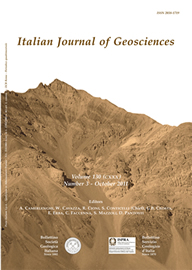
Calcareous Nannofossil and Planktonic Foraminifera Biostratigraphy of selected Piacenzian-Gelasian Laminites from Southern Italy
Enrico Di Stefano(*), Luca Capraro(**), Alessandro Incarbona(*), Francesco Massari(**), Rodolfo Sprovieri(*) & Sergio Bonomo(***)
(*) Università di Palermo, Dipartimento di Scienze della Terra e del Mare, Via Archirafi, 22 - 90134 Palermo, Italy. Corresponding author e-mail: edist@unipa.it
(**) Università di Padova, Dipartimento di Geoscienze, Via Giotto, 1 - 35137 Padova, Italy.
(***) Consiglio Nazionale delle Ricerche, Institute of Biomedicine and Molecular Immunology, Via U. La Malfa, 153 - 90146 Palermo.
Volume: 130 (2011) f.3
Pages: 343-351
Abstract
Here we present the biostratigraphic and chronostratigraphic framework of a number of selected diatomaceous laminated intervals from the Crotone Basin (Calabria, Southern Italy). These layers, which we consider correlative to the Eastern Mediterranean Sapropel Layers, range in age from the early Piacenzian to the Gelasian, and show surprising thicknesses, suggesting that they were probably laid down in a landlocked, overfed basin.
Specifically, a thick laminite from the surroundings of Cropani (Catanzaro) can be ascribed to nannofossil biozone MNN 16a and planktonic foraminifera biozone MPL 4b (lower Piacenzian) according to the Mediterranean calcareous plankton biostratigraphic zonations.
Two laminites from the "Muto" Section (Botricello-Cutro road, Crotone), belong to MPL 5a and MNN 16b/17 Zones (upper Piacenzian). A very thick laminite from the "Timpone dell'Inferno" badland area (near Termine Grosso, Catanzaro), belong to MPL 5b and MNN 18 Zones (middle-upper Gelasian). These biostratigraphic constraints provide a first contribution to a comprehensive paleoenvironmental reconstruction.
Keywords
Get Full Text